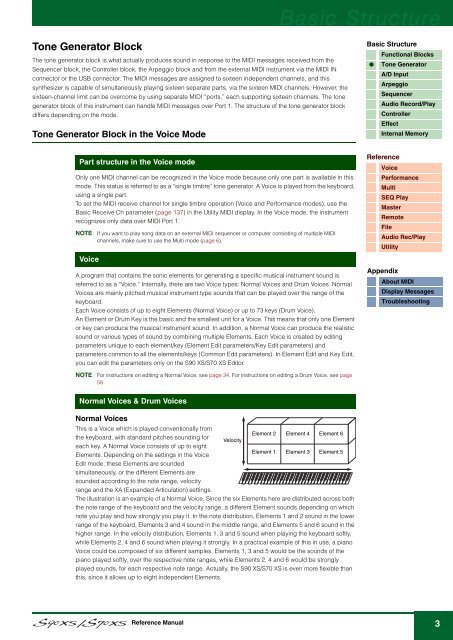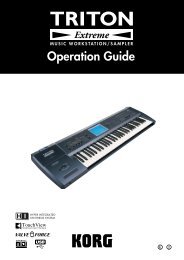S90 XS/S70 XS Reference Manual - zZounds.com
S90 XS/S70 XS Reference Manual - zZounds.com
S90 XS/S70 XS Reference Manual - zZounds.com
You also want an ePaper? Increase the reach of your titles
YUMPU automatically turns print PDFs into web optimized ePapers that Google loves.
Tone Generator Block<br />
The tone generator block is what actually produces sound in response to the MIDI messages received from the<br />
Sequencer block, the Controller block, the Arpeggio block and from the external MIDI instrument via the MIDI IN<br />
connector or the USB connector. The MIDI messages are assigned to sixteen independent channels, and this<br />
synthesizer is capable of simultaneously playing sixteen separate parts, via the sixteen MIDI channels. However, the<br />
sixteen-channel limit can be over<strong>com</strong>e by using separate MIDI “ports,” each supporting sixteen channels. The tone<br />
generator block of this instrument can handle MIDI messages over Port 1. The structure of the tone generator block<br />
differs depending on the mode.<br />
Tone Generator Block in the Voice Mode<br />
Part structure in the Voice mode<br />
Only one MIDI channel can be recognized in the Voice mode because only one part is available in this<br />
mode. This status is referred to as a “single timbre” tone generator. A Voice is played from the keyboard,<br />
using a single part.<br />
To set the MIDI receive channel for single timbre operation (Voice and Performance modes), use the<br />
Basic Receive Ch parameter (page 137) in the Utility MIDI display. In the Voice mode, the instrument<br />
recognizes only data over MIDI Port 1.<br />
NOTE If you want to play song data on an external MIDI sequencer or <strong>com</strong>puter consisting of multiple MIDI<br />
channels, make sure to use the Multi mode (page 6).<br />
Voice<br />
A program that contains the sonic elements for generating a specific musical instrument sound is<br />
referred to as a “Voice.” Internally, there are two Voice types: Normal Voices and Drum Voices. Normal<br />
Voices are mainly pitched musical instrument type sounds that can be played over the range of the<br />
keyboard.<br />
Each Voice consists of up to eight Elements (Normal Voice) or up to 73 keys (Drum Voice).<br />
An Element or Drum Key is the basic and the smallest unit for a Voice. This means that only one Element<br />
or key can produce the musical instrument sound. In addition, a Normal Voice can produce the realistic<br />
sound or various types of sound by <strong>com</strong>bining multiple Elements. Each Voice is created by editing<br />
parameters unique to each element/key (Element Edit parameters/Key Edit parameters) and<br />
parameters <strong>com</strong>mon to all the elements/keys (Common Edit parameters). In Element Edit and Key Edit,<br />
you can edit the parameters only on the <strong>S90</strong> <strong>XS</strong>/<strong>S70</strong> <strong>XS</strong> Editor.<br />
NOTE For instructions on editing a Normal Voice, see page 34. For instructions on editing a Drum Voice, see page<br />
58.<br />
Normal Voices & Drum Voices<br />
Normal Voices<br />
This is a Voice which is played conventionally from<br />
the keyboard, with standard pitches sounding for<br />
each key. A Normal Voice consists of up to eight<br />
Velocity<br />
Element 2 Element 4 Element 6<br />
Elements. Depending on the settings in the Voice<br />
Edit mode, these Elements are sounded<br />
simultaneously, or the different Elements are<br />
sounded according to the note range, velocity<br />
range and the XA (Expanded Articulation) settings.<br />
Element 1 Element 3 Element 5<br />
The illustration is an example of a Normal Voice. Since the six Elements here are distributed across both<br />
the note range of the keyboard and the velocity range, a different Element sounds depending on which<br />
note you play and how strongly you play it. In the note distribution, Elements 1 and 2 sound in the lower<br />
range of the keyboard, Elements 3 and 4 sound in the middle range, and Elements 5 and 6 sound in the<br />
higher range. In the velocity distribution, Elements 1, 3 and 5 sound when playing the keyboard softly,<br />
while Elements 2, 4 and 6 sound when playing it strongly. In a practical example of this in use, a piano<br />
Voice could be <strong>com</strong>posed of six different samples. Elements 1, 3 and 5 would be the sounds of the<br />
piano played softly, over the respective note ranges, while Elements 2, 4 and 6 would be strongly<br />
played sounds, for each respective note range. Actually, the <strong>S90</strong> <strong>XS</strong>/<strong>S70</strong> <strong>XS</strong> is even more flexible than<br />
this, since it allows up to eight independent Elements.<br />
<strong>Reference</strong> <strong>Manual</strong><br />
Basic Structure<br />
Basic Structure<br />
Functional Blocks<br />
Tone Generator<br />
A/D Input<br />
Arpeggio<br />
Sequencer<br />
Audio Record/Play<br />
Controller<br />
Effect<br />
Internal Memory<br />
<strong>Reference</strong><br />
Voice<br />
Performance<br />
Multi<br />
SEQ Play<br />
Master<br />
Remote<br />
File<br />
Audio Rec/Play<br />
Utility<br />
Appendix<br />
About MIDI<br />
Display Messages<br />
Troubleshooting<br />
3
















